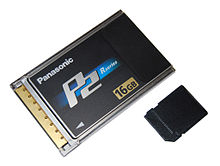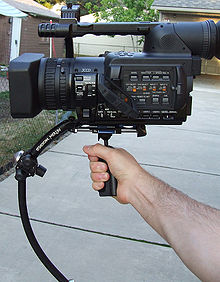- P2 (storage media)
-
P2  A 16 GB P2 card next to a Secure Digital card
A 16 GB P2 card next to a Secure Digital card
Media type Flash Memory Encoding NTSC, PAL, High-definition video Developed by Panasonic Usage Video production P2 (P2 is a short form for "Professional Plug-In") is a professional digital recording solid-state memory storage media format introduced by Panasonic in 2004, and especially tailored to electronic news-gathering (ENG) applications. It features tapeless (non-linear) recording of DV, DVCPRO, DVCPRO25, DVCPRO50, DVCPRO-HD, or AVC-Intra streams on a solid-state flash memory. The P2 card is essentially a RAID of Secure Digital (SD) memory cards with an LSI controller tightly packaged in a die-cast PC Card (formerly PCMCIA) enclosure, so data transfer rate increases as memory capacity increases. The system includes cameras, decks as drop-in replacements for Videocassette recorders (VCR), and a special 5.25-inch computer drive for random-access integration with non-linear editing systems (NLE). The cards can also be used directly where a PC card (PCMCIA) slot is available, as in most older notebook computers, as a normal hard disk drive, although a custom software driver must first be loaded.
As of early 2010, P2 cards are available in capacities of 4, 8, 16, 32 and 64 GB. At introduction, P2 cards offered low recording capacity compared to competing, video tape-based formats (a miniDV tape holds roughly 13 GB of data, and an S-size HDCAM tape holds 50 GB). To solve this, camcorders and decks using P2 media employ multiple card slots, with the ability to span the recording over all slots. Cards are recorded in sequence, and when a card is full, it can be swapped out while another card is recording. This limits recording time only by power supply and the available number of cards. If a card is partially full, the deck will record only until it is full. Unlike video tape, old video cannot be recorded over accidentally; old footage must be manually deleted.
P2 cards are of a ruggedized PCMCIA type with the fastest transfer speeds currently available through this format. The card also contains a processor that organizes and safeguards the files and the case is developed and crafted to "military" (according to Panasonic) specifications, making P2 cards tough and reliable.
The first pieces of equipment released by Panasonic which use the P2 format included the AJ-SPX800 (a 2/3" broadcast camcorder for ENG and EFP applications), the studio recorder AJ-SPD850, the AJ-PCD10 offload device (basically, a five-slot PC card reader with USB interface designed to fit a 5-1/4" IT systems bay), and the memory cards themselves – AJ-P2C004 (4 GB) and AJ-P2C002 (2 GB). Panasonic is currently shipping a wide range of camcorders that support the P2 format, including the professional video camera AG-HVX200 HD handheld camcorder, and the high-end, or broadcast professional shoulder-mount AG-HPX500, AJ-HPX2000, and AJ-HPX3000 camcorders. Panasonic has also announced the P2-based AG-HPX170 handheld HD tapeless camcorder. The HPX170 is very similar to the HVX200 and the HVX200A, the main difference being the lack of a video tape drive on the 170. The latest products to feature P2 technology are the well-received[1] recently launched AJ-HPX2700 and AH-HPX3700 "Varicam" high end cameras.
Contents
Specifications
- File format: MXF
- Maximum datarate: 1.2 Gbit/s[2]
- Available sizes: 2 GB, 4 GB, 8 GB, 16GB, 32GB, 64GB
- Form factor: PC card (PCMCIA) type II
P2 Workflow
P2 is a solid state technology, and as such departs from the older method of recording video onto video tape. Since the video output is saved onto a solid state P2 memory card as a file, many possibilities are opened up to change the approach to workflow; indeed, it is claimed that the workflow can be sped up and made more reliable, which in turn, reduces production costs.[3] Since its inception, the development of this workflow, together with partners such as Avid and Apple, has matured, and has been adopted by many major production teams.[4] However for many in the post production field the P2 format is quite troublesome. Because no hard copy is produced from the camera, editors must rely on massive amounts of stable drive space for security. The raw files on the card are usually treated as the 'tape', and then the converted Quicktime files are treated as capture.
P2 prices have come down thanks to advances in storage technology. Since tapes can only be rewritten a few times, and P2 can be rewritten over 1825 times[citation needed], P2 is much cheaper per shoot over the life of the media. P2 footage can also be archived to disk, hard drive or any other digital storage media. The low cost of blu-ray and DVD media makes archival of P2 footage relatively cheap.
P2 Card Run Times Timetable
Model # Capacity DVCPro DVCProHD 720pN24 DVCPro50, DVCProHD 720p30, or AVC-Intra 50
DVCProHD at 1080i60 or 720p60, or AVC-Intra 100
AJ-P2C004H 4GB 16 min. 10 min. 8 min. 4 min. AJ-P2C008H 8GB 32 min. 20 min. 16 min 8 min. AJ-P2C016H 16GB 1 hr. 4 min. 40 min. 32 min. 16 min AJ-P2C032H 32GB 2 hrs. 8 min. 1 hr. 20 min. 1 hr. 4 min. 32 min. AJ-P2C064H 64GB 4 hrs. 16 min. 2 hr. 40 min. 2 hr. 8 min. 64 min. 2 GB P2 cards are not supported in DVCProHD applications. Panasonic recently published a slightly more complicated version of this table for 16 and 32 GB cards.[5]
P2 Current Camera Range
Handheld models
AG-HPX170 (NTSC version)
- Compact, Lightweight HD/SD Camera-Recorder
- 13x zoom lens with 28mm wide-angle
AG-HPX171 (European version)
- Compact, Lightweight HD/SD Camera-Recorder
- 13x zoom lens with 28mm wide-angle
- Improved ergonomics, features and image quality compared to its predecessor
AG-HVX201
- Progressive native 16:9 HD 3CCD imaging system
- HD quality Leica Dicomar wide-angle zoom lens
- Progressive modes supported
Shoulder Mount Models
AG-HPX300
- 3 pieces of 1/3-inch MOS image sensor (1920x1080 pixels each)
- Removable 1/3-inch lens
- AVC-Intra 50/100 and DVCPRO HD/50/25 codecs compatible
- Variable Frame Rate
- LCoS viewfinder
- Two P2 slots
AG-HPX301E NEW[6]
- As above but with many improvements
AG-HPX370/371
- New 2,2MPx MAICO CMOS sensor with improved sensitivity F11
- Other features as above HPX301
AG-HPX500
- 3 pieces of 2/3-inch CCD image sensor (960x540 pixels each)
- DVCPRO HD/50/25 codecs compatible
- Variable Frame rate function
- Four P2 slots
AJ-HPX2100
- 3 pieces of 2/3-inch CCD image sensor (1 million pixels each)
- DVCPRO HD codecs compatible
- AVC-Intra 50 codec as an option
- Five P2 slots
AJ-HPX2700
- One of the new P2 Varicam range
- Variable Frame Rate of 1 frame/s to 60 frame/s
- 10 bit/4:2:2 Recording with Full Sampling
- AVC-Intra codec recording system
AJ-HPX3000- DVCPRO HD/AVC-Intra codecs compatible
- Native 1080p 4:2:2 10-bit
- Newly developed high-resolution 2.2-megapixel CCD
AJ-HPX3700
- Super High-End HD Camera-Recorder for Cinema Production , part of the P2 Varicam range
- RGB 4:4:4 and 24PsF Output
- AVC-Intra codec recording system
References
- ^ Independent P2 Varicam review
- ^ Panasonic product listing of E-series P2 cards
- ^ Panasonic Professional User Group Interviews
- ^ Panasonic Professional User Group References
- ^ Panasonic P2 Panasonic Guidebook
- ^ Independent In depth AG-HPX301E review
External links
- MXF Aware drives for P2 post-production from Craystone of Bolton
- P2 AG-HVX-202 review
- Panasonic's DVCPRO P2 product overview
- P2 Overview at dvxuser.com
- Panasonic Announces Upgrades To P2 Solid-State Memory Drive. February 26, 2006.
- Specifications of P2 cards at the Panasonic Broadcast Europe Site. December 2, 2008
- P2 Camera in the field
- Overview of the new P2 Varicam
- P2 AG-HMC151 Review
- P2 AG-HPX500 review
- P2 product under test
- The P2 HPX3000 reviewed
- P2 media and Avid Workflow
- P2 media and Avid Workflow
- More P2 media and Avid workflow information
- A P2 tutorial from Creative Cow
- A Video tutorial showing an end to end workflow
- Wikipedia's Varicam page
Video storage formats Videotape Quadruplex (1956) · VERA (1958) · Sony 2 inch helical VTR (1961) · Ampex 2 inch helical VTR (1962) · Type A (1965) · CV-2000 (1965) · Akai (1967) · U-matic (1969) · EIAJ-1 (1969) · Cartrivision (1972) · Philips VCR (1972) · V-Cord (1974) · VX (1974) · Betamax (1975) · IVC (1975) · Type B (1976) · Type C (1976) · VHS (1976) · VK (1977) · SVR (1979) · Video 2000 (1980) · CVC (1980) · VHS-C (1982) · M (1982) · Betacam (1982) · Video8 (1985) · MII (1986) · S-VHS (1987) · S-VHS-C (1987) · Hi8 (1989) ·
D1 (1986) · D2 (1988) · D3 (1991) · DCT (1992) · Digital Betacam (1993) · D5 (1994) · Digital-S (D9) (1995) · Betacam SX (1996) · Digital8 (1999) · MicroMV (2001) ·
High DefinitionVideodisc AnalogDigitalHigh DefinitionMUSE Hi-Vision LD (1994) · HD DVD (2006) · Blu-ray Disc (2006) · HVD (Holographic Versatile Disc) (2007) · CBHD (2008)
Digital Media agnosticTapelessP2 (2004) · SxS(2007)
Video recorded to film Kinescope (1947) · Electronicam kinescope (1950s) · Electronic Video Recording (1967)
Memory cards Main articles Memory card reader • Comparison of memory cards • SD Card and MultiMediaCard family comparison
Types CompactFlash (CF) • Express Card • JEIDA • MultiMediaCard (MMC) • Memory Stick (MS/MS-PRO) • miCard • Microdrive (MD) • MiniCard • P2 • PC Card (PCMCIA, CardBus, CardBay) • Secure Digital (SD) • SmartMedia (SM) • SxS • Universal Flash Storage (UFS) • USB • xD-PictureCategories:- Video storage
- Solid-state computer storage media
Wikimedia Foundation. 2010.

